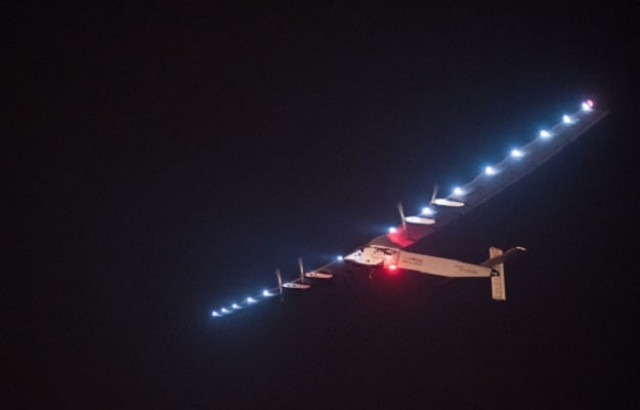Solar Impulse arrives in Hawaii to complete historic fossil-fuel less flight
The 4,000-mile leg from Japan to Hawaii was world's longest solar-powered, solo flight by time and distance

The sun-powered plane, piloted by veteran Swiss aviator Andre Borschberg, took five days to make the historic voyage from Japan to Hawaii and landed shortly after dawn at Kalaeloa Airport on the main Hawaiian island of Oahu.
"Just landed in #Hawaii with @solarimpulse! For @bertrandpiccard and I, it's a dream coming true," Borschberg tweeted triumphantly upon after completing the most dangerous leg of the around-the-world journey.
Just landed in #Hawaii with @solarimpulse! For @bertrandpiccard and I, it's a dream coming true pic.twitter.com/0y3xhIbnXN
— André Borschberg (@andreborschberg) July 3, 2015
HE MADE IT! @andreborschberg just touched down in #Hawaii after a record-breaking flight! #futureisclean @b... https://t.co/WQWsRKiCEi
— Solar Impulse Foundation (@solarimpulse) July 3, 2015
Borschberg and Bertrand Piccard have been alternating the long solo flights aboard the plane. The flight from Japan to Hawaii was the eighth of 13 legs.
His colleague and tag-team copilot on the venture, Piccard expressed elation over the arrival of aircraft and pilot.
Difficult to believe what I see: #Si2 in Hawaii! But I never had doubts that @andreborschberg could make it! pic.twitter.com/XwJQCDBO66
— Bertrand PICCARD (@bertrandpiccard) July 3, 2015
This flight to Hawaii is not only an aviation historic first, but also a historic first for energy and cleantechs pic.twitter.com/FhIq4YemFN
— Bertrand PICCARD (@bertrandpiccard) July 3, 2015
The experimental plane touched down in Hawaii shortly after dawn -- a little after 1600 GMT -- amid cheers and applause from the ground crew. Borschberg, all smiles, emerged a short time time later from the cockpit.
Sunlight glimmered on the horizon as the Solar Impulse ground crew burst into cheers and applause upon completion of the groundbreaking flight, whose progress was streamed live at the solar impulse website.
The plane landed around noon ET at Hawaii's Kalaeloa Airport after an arduous five-day, non-stop flight, according to Solar Impulse's website, which livestreamed the event.
The completed 4,000-mile leg from Nagoya, Japan, to Hawaii was not only the world's longest solar-powered flight both by time and distance, it also set the record for longest solo flight by time.
As the flight neared its destination, the Solar Impulse team tweeted images and videos of the plane over Hawaii.
Earlier Friday, founder of Virgin Group Richard Branson congratulated the Solar Impulse team on Twitter for beating Virgin's record non-stop solo flight without refueling.
117 hours and 52 seconds over the Pacific to reach Hawaii. Not one single drop of fuel. #futureisclean pic.twitter.com/pFwbYyaneZ
— Solar Impulse Foundation (@solarimpulse) July 3, 2015
"The #solarteam made it. WE MADE IT, YOU MADE IT THANKS TO YOUR SUPPORT!"read a message posted under the Twitter handle @solarimpulse.
.@andreborschberg, @bertrandpiccard, the #solarTEAM made it! WE MADE IT, YOU MADE IT THANKS TO YOUR SUPPORT! pic.twitter.com/uobncQ7MbF
— Solar Impulse Foundation (@solarimpulse) July 3, 2015
The aircraft over the course of the journey set records for longest solo flight and most time in a solar-powered flight.
The flight tested its exhausted pilot to the limit, in what his team described as "difficult" conditions.
Mission organizers described the journey as having taken "pilot and aircraft to the limits" of their endurance.
The whole trip from Japan to Hawaii took about four days and 22 hours, with the Swiss aviator taking catnaps of only 20 minutes at a time to maintain control of the pioneering plane.
Borschberg easily beat the previous longest solo endurance flight by Steve Fossett, who flew for 76 hours and 45 minutes in 2006.
Fellow pioneering aviator and rival Richard Branson tweeted his congratulations to Borschberg just before his competitor touched down.
Congrats @SolarImpulse, beating @Virgin GlobalFlyer record non-stop solo flight without refuelling. Huge step forward http://t.co/jfl0G8nfVF
— Richard Branson (@richardbranson) July 3, 2015
Alone throughout the entire flight and utterly self-reliant in the unpressurized cockpit, Borschberg was equipped with a parachute and life raft, in case he needed to ditch in the Pacific.
The solar-powered aircraft left Japan around 1800 GMT Sunday -- the early hours of Monday local time -- after spending a month in the central city of Nagoya.
The propeller-driven plane was originally scheduled to fly directly from Nanjing in China to Hawaii, but bad weather along the way forced a diversion to Japan that stretched to a month.
Traveling at altitudes of more than 9,000 meters (29,500 feet), Borschberg at times had to use oxygen tanks to breathe and experienced huge swings in temperature throughout.
Solar Impulse 2 set off from Abu Dhabi earlier this year in a multi-leg attempt to fly around the world without a single drop of fuel.
It has 17,000 solar cells and on-board rechargeable lithium batteries, allowing it to fly through the night.
Its wingspan is longer than that of a jumbo jet but it weighs only 2.3 tonnes -- about the same as a car.






1701351241-1/Afghan-refugees-(3)1701351241-1-208x130.webp)












COMMENTS
Comments are moderated and generally will be posted if they are on-topic and not abusive.
For more information, please see our Comments FAQ